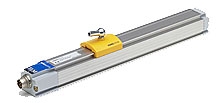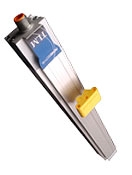TLM Story

CALL 1-800-667-7492
T: 1-800-667-7492

TLM Story

High Definition Means Getting Significantly More-Accurate Data 8X Faster Than The Competition Can Deliver
Take the Novotechnik TLM high-definition, non-contact position sensor as an example. This is the first sensor to measure velocity as well as position; the first to validate that the data arriving at your controller isn't corrupted by spurious noise from the machinery and electrical equipment found in manufacturing and hospital environments. And, as you'll see, Novotechnik TLM Series of non-contact position sensors provide a significantly more accurate measurement of linear position than competitive position sensors and transmits those measurements to your signal processor at a rate 8 times faster than competitive devices.
The key to superior accuracy combined with faster measurement and reliability is Novostrictive¨ technology, Novotechnik's proprietary non-contact magnetostrictive process for the direct, precise, and absolute measurement of length of travel
What's In It For Design Engineers and Their Customers
Novotechnik's new technology advances in TLM position sensors combine to provide engineers and end-users unmatched reliability, control and accuracy for very diverse applications.
Position information that's available to your signal processing front-end over 8X sooner than the nearest competing position sensor. It goes beyond being great for high-speed applications, it's better for many other applications too. Faster start-up times and tighter control over a small length of overall distance traveled are two areas that benefit.
There's even more benefits from other new technologies incorporated into these sensors. TLM is the first position sensor to provide actual velocity information - not just an approximation. It is also the first to provide data validation information to confirm the value arriving at your controller bus wasn't corrupted by spurious noise from other machines in a production or even a hospital environment. Before describing more benefits, let's start at the beginning?
The Novostrictive Position Measuring Process
The TLM Series employs the Novostrictive non-contact magnetostrictive process for direct, precise and absolute measurement of length of travel. These sensors eliminate contact resistance and linearity errors resulting from mechanical couplings as measurements are made by using one or more passive position markers which move as free floating elements. There is no mechanical linkage to wear either. In addition to analog, SSI and Start/Stop interfaces, the TLM series is available with Novotechnik's ground-breaking DyMoS interface that, in addition to position value, transmits actual transverse velocity.
True Accuracy vs. Specmanship
Spec 'N Switch-- Many manufacturers specify linearity at say 0.02% (0.04 mm), measuring it at full stroke length. Novotechnik's absolute linearity spec applies to your exact stroke regardless of overall length of the transducer.
The difference comes when, for example, your application calls for a measurement of say 510 mm. Obviously this requires a sensor that is larger than 500 mm, say the next size up is a 1,000 mm sensor. Other manufacturers' sensors spec linearity as a percent of the full stroke length. You would get a more accurate measurement with your shorter stroke from a TLM with linearity specified at the same or even greater numerical value, as it is an absolute spec (actual length used, not full scale).

All too often, other manufacturers specify multiple specs for one output type on a sensor. This spec 'n switch is at best confusing and could lead to a nasty surprise later. Some specify vital attributes like linearity, resolution or repeatability in terms of less than a percentage of full stroke length or a shorter fixed-length in milimeters, whichever is greater. One went so far as to specify resolution in the preceding terms and add that it was controller dependent!
Manufacturer's specifications also assume that sensors are properly adjusted. It is often left up to the user to perform bothersome and time-consuming wave speed, span or zero adjustments. If these adjustments are made properly, the sensor will meet manufacturer's specs. The technological advances incorporated into Novotechnik TLM sensors eliminate the need for user adjustment. It is not up to the user to bring the position sensor up to spec. At the same time, because TLM sensors have no moving parts and meet protection class IP67, accuracy is constant over a virtually unlimited mechanical life.
First Pass The Post
When measuring speed, the only spec that counts is the update rate, the time/rate at which new data is available. Novotechnik's new TLM series are the first to deliver a data output rate of 62.5µsec which equates to 16kHz for all digital outputs. This makes them the industries fastest position sensors by a substantial margin. This is important, even though your application may not be a fast moving process. High speed means faster start up, higher accuracy, and verification and retention of correct output values.
Don't Miss the Bus
TLM sensors are the first position sensors to incorporate a 48-bit bus. Novotechnik's proprietary DyMoS bus is compatible with SSI hardware while outputting actual velocity - not approximations. At the same time, DyMos provides data transfer error checking via a CRC data integrity check generated in logic augmenting a DSP. In addition, DyMoS transmits system information including error and function bits, stroke length, serial number and other system data.
Did You Catch It Within, Or Out-Of-Bounds?

Speaking of bus capabilities and passing the accuracy post, with closed-loop control systems, target position overrun is an important issue. Other manufacturers' sensors send "ghost signals" that cause a customer's signal processor to indicate the sensor's floating marker is within range when, in reality, it is out-of-range. Novotechnik solved this issue by creating a proprietary predictive position algorithm and integrated it into the TLM's ASIC. This algorithm utilizes TLM's actual speed and precision position measurement capabilities to determine exactly where the position marker will be located when the output signal is transmitted to a customer's processing unit. To confirm these results on your system, Novotechnik included an error bit in its DyMoS bus that confirms your TLM position marker is within the defined measurement range.
Will You Take The Heat?
Complete specs are important so you don't get blind sided after hundreds or thousands of units of your product are in operation. Temperature is a significant factor that can't always be overlooked. You can't always predict the environmental conditions in a customer's location. Or, if the sensor you used is sitting in a machine with substantial heat-rise, temperature can play an important role in reliability and predictability. A small 10¡ rise in temperature can cause a 0.06 % change in a specification for a sensor with a 60 ppm/K tempco spec. Add that to your error budget if you canÐsome manufacturers have a very convoluted formula, others don't even give you the spec. Fortunately, Novotechnik TLM sensors clearly specify this important factor at a low value of <20ppm/K for digital or <30ppm/K for analog outputs.
Technology Is The Key to Lower Prices
Not just price/performance; TLM sensors actually cost less than conventional magnetostrictive sensors that can't match TLM specs. The key is Novostrictive™ technology that simplified design and manufacturing to provide a better product at a lower price than any magnetostrictive sensor on the market today.
Compare These Key Specs Against the Competition
- Fastest non-contacting sensor at 62.5µsec update time
- Outstanding linearity to <±30 µm
- Resolution to <1 µm regardless of stroke lengt
- Stroke length 100 to 4500 mm
- Low temperature coefficient of <20 ppm/K
- Protection Class IP 67
| Rod Type | Touchless | Side Actuated | Rod Type With Return Spring | in-Cylinder | Open Systems |
| Shaft Type | Touchless Rotary | Hollow Shaft | Multi-Turn | Automotive | Open Systems |
| ABOUT | TERMS AND CONDITIONS | PRIVACY |
© 2000-2023 Novotechnik U.S. Inc., All Rights Reserved




